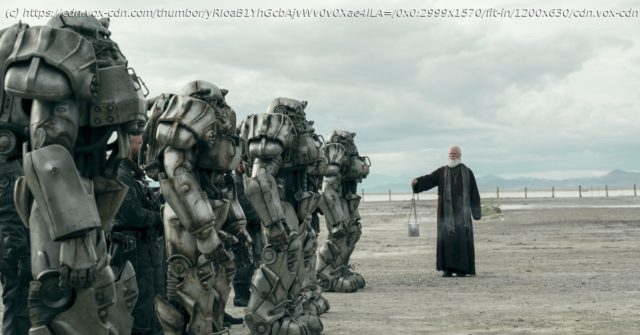The Prime Video adaptation of Bethesda’s Fallout franchise went for practical effects in everything from Pip-Boys to power armor. Here’s why Jonathan Nolan wanted that.
Fallout is a show totally committed to its world. This instinct goes deeper than just embracing the irreverent tone, lore, or story of the games the Prime Video series adapted. Instead, it’s about making the terrain of Fallout’s Wasteland feel lived-in and real — right down to making the gadgetry actually function.
“We were never going to beat Bethesda with computer graphics,” executive producer Jonathan Nolan tells Polygon. “Those games are so beautifully made. The one thing we can add, the one thing that we could bring to the table, was reality. So we took a page from Ridley Scott’s book for the original Alien.”
That meant building a ton of original props for the show — a Mr. Handy puppet threatening Ella Purnell’s Lucy, a Nuka-Cola bottle buried in the sands of Namibia, and several actually functional Pip-Boys (albeit slightly smaller than their video game counterparts). It also, most importantly, meant building actual power armor for the Brotherhood of Steel.
The armor had to be the very first thing that Fallout production designer Howard Cummings started on. “I had never done [armor like that], but I knew it took a whole lot of time. So I called a bunch of people who worked on things like Iron Man,” Cummings says, noting it was early enough that there wasn’t even an assigned producer on the show. He and his team (then just two prop guys) eventually started working with a company called Legacy, which had indeed worked on Tony Stark’s Iron Man suits starting with Iron Man 2. Co-showrunners Geneva Robertson-Dworet and Graham Wagner picked the T-60 for the main season 1 power armor model, which gave Cummings a virtual model to work off of. (“I like the T-60,” says Cummings. “It’s funky, you know, in a good way, and kind of klutzy.”) But even with all that squared away, Cummings gave the team a new challenge: building a whole suit.
“Even Iron Man — I think the suit started more full, and then it got shrunk down to pieces, because it’s so difficult for the actors,” Cummings says of Marvel’s past metal-suit efforts.
Start
United States
USA — software Fallout took the Alien approach with the Brotherhood of Steel — and...






